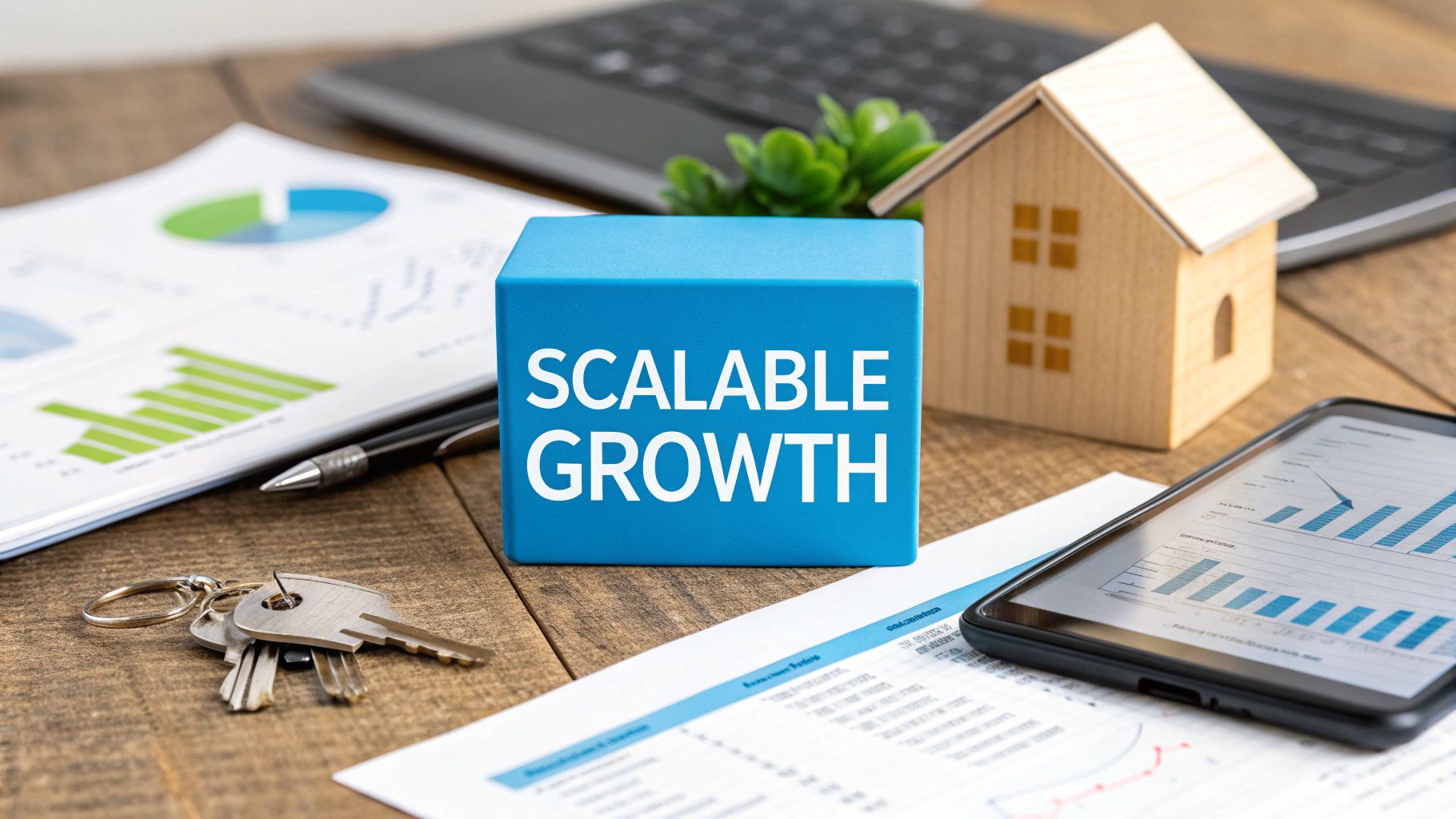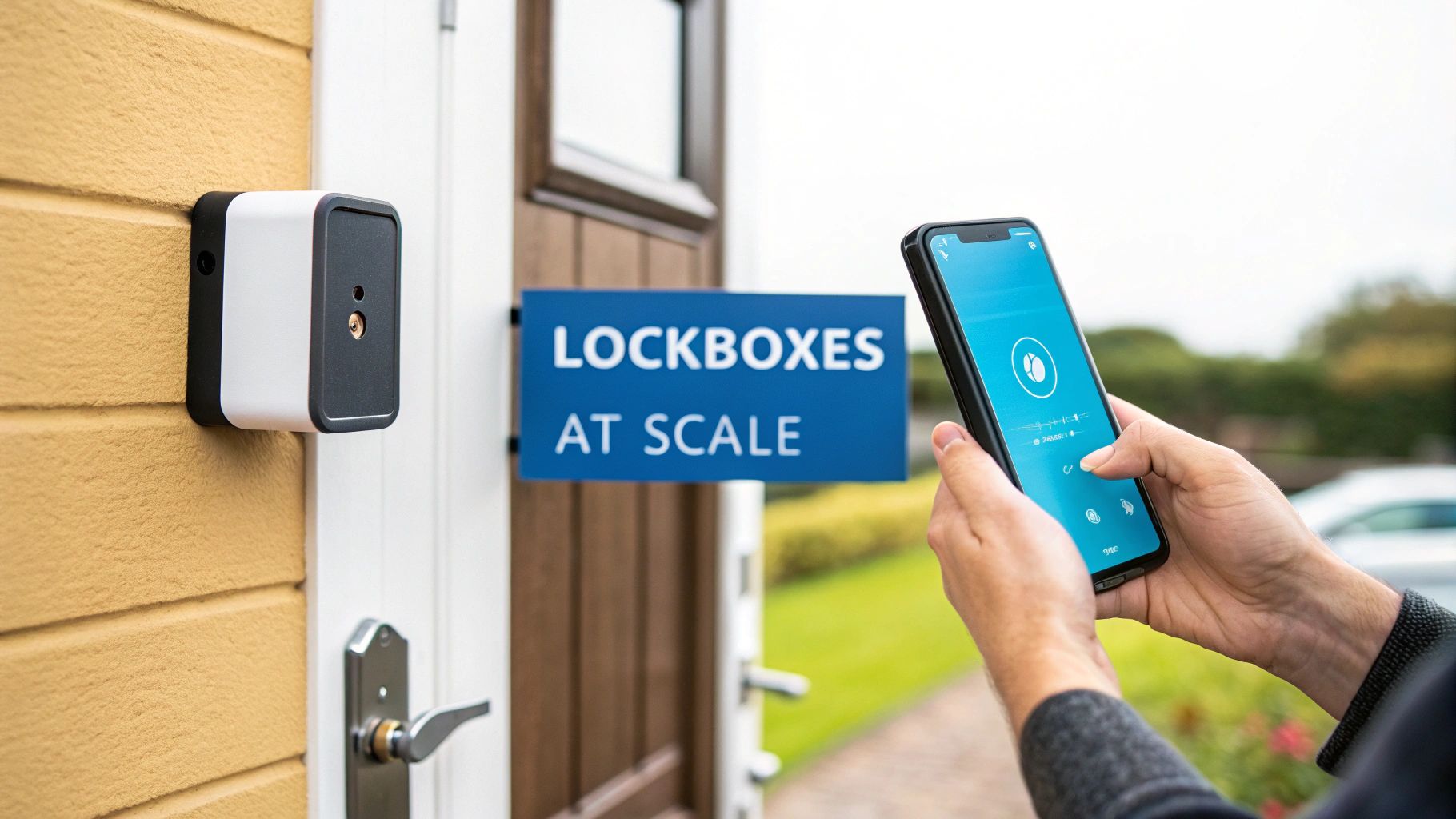For operations leaders at large-scale property management companies, the term "property management group" means something very different today than it did a decade ago. It’s no longer just about collecting rent and fixing leaky faucets.
A modern property management group is the operational control tower for your entire rental portfolio. They’ve become strategic partners for companies juggling hundreds or even thousands of units, centralizing the messy, time-consuming parts of leasing and maintenance to slash Days on Market (DOM), drive cost-per-door efficiency, and pave the way for scalable growth.
What Is a Modern Property Management Group?

Today's top-tier groups are sophisticated operational hubs. They're built from the ground up to solve the puzzle of managing geographically scattered assets, a massive headache for portfolios of single-family rentals (SFR) and multi-family units without dedicated onsite staff at every location.
Their real value lies in systemizing the entire leasing lifecycle to accelerate speed-to-lease. They take on the critical, hands-on tasks that make or break your revenue and key performance indicators (KPIs). Instead of your internal team getting buried under a mountain of tour requests and maintenance calls, a specialized group handles it all with precision, directly impacting your lead-to-tour conversion rates.
This shift isn't happening in a vacuum. The global property management market hit USD 21.75 billion this year and is on track to explode to nearly USD 52.99 billion by 2033, with a compound annual growth rate (CAGR) of 10.4%. That kind of growth tells you one thing: demand is surging for specialized, tech-forward services that deliver real, measurable results. You can learn more about the property management market's growth projections and the trends driving it.
The Operational Control Tower Analogy
Imagine your portfolio is an airport. Your properties are the planes, and prospective tenants are the passengers. A property management group is the air traffic control tower.
Their job is to ensure every "flight"—from the first lead inquiry to the final lease signing—is handled smoothly and safely. No collisions, no delays. They manage all the complex logistics so your core team can stay focused on the big picture: strategy, asset performance, and portfolio growth.
Centralizing Key Leasing Functions
The secret sauce of a modern property management group is centralization. They create consistency and efficiency across your entire portfolio, a game-changer when you're managing properties in different cities or states where standardizing anything is a huge challenge.
A few of the key functions they typically centralize include:
- Lead Management: They field every initial inquiry and pre-qualify prospects around the clock, 24/7. This is all about maximizing your lead-to-tour conversion rates so no opportunity is missed.
- Tour Coordination: They schedule and manage showings across hundreds of units at once, using either a network of on-demand agents or self-showing technology.
- Application Processing: They handle the nitty-gritty of verifying applicant info and prepping lease documents, all to get that signature faster.
By bringing these tasks under one roof, a property management group eliminates the operational bottlenecks that kill your cash flow. Every day a unit sits empty is a day of lost revenue, and their entire model is built to shrink that speed-to-lease timeline.
Core Functions of a Property Management Group at Scale
Ultimately, by taking ownership of these core responsibilities, a property management group doesn't just lighten the workload—it provides the structure needed to operate efficiently at a scale that would otherwise be impossible.
The Strategic Benefits for Large Portfolios
When your portfolio grows beyond a few hundred units, bringing on a specialized property management group isn't just about handing off tasks—it’s a strategic play that directly impacts your bottom line. Think of the right partner as a force multiplier for your operations team. They provide the infrastructure to scale your operations in a way that would be next to impossible to build in-house without exploding your overhead costs.
Instead of getting stuck in the endless cycle of hiring, training, and managing massive teams across different markets, you can simply plug into an infrastructure that’s already built for peak efficiency. This frees up your core team to zero in on what really moves the needle, like asset management and plotting your next big growth move, rather than getting buried in the daily grind of leasing and maintenance calls.
Drive Down Days on Market (DOM)
Every single day a unit sits empty, you're losing money. For a portfolio with 1,000 units at an average rent of $2,000/month, shaving just five Days on Market (DOM) per unit turnover can put over $330,000 back into your net operating income annually. Property management groups live and breathe this metric.
They attack DOM from all sides:
- Instant Lead Response: They have systems to capture and qualify leads 24/7. A hot prospect gets an answer right away, before they have a chance to click on the next listing.
- Same-Day Showings: Whether they use on-demand agent networks or self-showing tech, they can get a qualified renter through the door in hours, not days. That speed is absolutely crucial for maximizing your lead-to-tour conversion.
- Streamlined Applications: They've ironed out the kinks in the application and lease-signing process, getting rid of those frustrating bottlenecks that add extra vacancy days.
By turning the leasing funnel into a well-oiled machine, these specialized groups create a predictable, repeatable process that consistently slashes the time from listing to lease. That operational discipline is the secret to crushing vacancy loss when you're operating at scale.
Optimize Cost Per Door and ROI
As you scale, keeping a lid on operational costs becomes everything. A specialized property management group helps you fine-tune your cost per door by turning what would be fixed expenses into variable ones. Instead of paying hefty salaries for an in-house leasing team that might be twiddling their thumbs during the slow season, you only pay for the services you actually use.
This model is a game-changer for portfolios spread across multiple markets, where keeping processes consistent and quality high is a constant battle. With one partner, you know every single property is following the same efficient playbook for leasing and maintenance, no matter where it's located. That consistency doesn't just make for happier tenants; it delivers financial results you can count on. If you're looking to really dig into financial performance, check out our guide on 8 ways to boost ROI for your properties.
The property management industry is booming for a reason. There are now approximately 325,037 property management businesses in the United States, a number that grew by 2.5% from the previous year. This isn't just random growth; it signals a real demand for specialized services that deliver tangible financial wins. You can discover more insights about property management business trends and see how the market continues to expand.
Key Services for Enterprise-Level Management
 When you're managing a massive portfolio, a generic checklist of services just doesn't cut it. Enterprise-level operations demand powerful solutions built for the unique headaches that come with hundreds or even thousands of scattered-site properties. This isn't about simply handing off tasks; it's about plugging into a scalable operational machine.
When you're managing a massive portfolio, a generic checklist of services just doesn't cut it. Enterprise-level operations demand powerful solutions built for the unique headaches that come with hundreds or even thousands of scattered-site properties. This isn't about simply handing off tasks; it's about plugging into a scalable operational machine.
The focus has to be on the numbers that actually move the needle for your bottom line: Days on Market (DOM), lead-to-tour conversion rates, and cost per door. It’s all about turning your leasing funnel from a clunky, manual process into an automated revenue driver.
Advanced Leasing and Showing Operations
The single biggest bottleneck for a dispersed portfolio? Coordinating showings. It's a logistical nightmare. Every hour you spend trying to line up a tour is another hour a great prospect might find a competitor’s property. Advanced leasing operations tackle this problem head-on by building a system designed for pure speed and accessibility.
This system really stands on two pillars:
- On-Demand Agent Networks: Forget trying to manage salaried leasing agents stretched thin across different cities. This model taps into a flexible network of licensed real estate agents who are ready to show properties seven days a week. It means when a qualified prospect inquires, they can often see the home the very same day.
- Self-Showing Technology: To give renters maximum flexibility, smart locks allow pre-screened prospects to tour a home on their own time. This is exactly what modern renters expect, and it dramatically expands the number of tours you can accommodate each day.
By blending these two strategies, property management groups can slash their DOM and watch lead-to-tour conversions climb. Hot leads simply don't have time to go cold.
The name of the game is removing friction from the leasing process. For a portfolio of 1,000+ units, making it incredibly easy for prospects to view properties is the fastest way to turn their interest into a signed lease.
Centralized Maintenance Coordination
Trying to manage maintenance requests across multiple markets without any onsite staff is a recipe for disaster. You end up with inconsistent repairs, unhappy tenants, and a major lack of oversight. A crucial service for any enterprise-level partner is a centralized maintenance coordination system that standardizes everything, from the initial work order to the final vendor payment.
This creates a single, reliable hub for all maintenance activity, ensuring your brand standards and quality are upheld no matter where a property is located. The right partner will use technology to track every single request, verify that the work was actually completed, and give you transparent reports—which is absolutely vital when you're managing from a distance.
Scalable Financial and Administrative Management
As your portfolio balloons, so does the complexity of rent collection, accounting, and reporting. A truly scalable property management group provides rock-solid financial services that plug right into your existing systems, ensuring a single source of truth for portfolio performance.
These services go way beyond simple bookkeeping. They deliver detailed, portfolio-wide reporting on key financial metrics, giving you the hard data needed to make smart, informed decisions. This centralized approach guarantees consistent processes for everything from tenant billing to owner distributions, keeping your operations humming efficiently as you grow.
How Technology Is Reshaping Property Management
For any operations team looking to grow, technology is the engine that keeps a modern property management group running. It’s what lets a portfolio scale from 100 to 5,000 units without watching overhead costs explode right along with it. The right PropTech stack is the difference between being reactive and proactive, turning the leasing funnel from a manual slog into a finely tuned, automated system.
The best groups don’t just use a random collection of software; they build an integrated ecosystem. It all starts with a solid Property Management System (PMS) and expands from there with powerful API connections. These links create a smooth, constant flow of data between leasing platforms, maintenance tools, and financial dashboards.
The end result? A single source of truth that gives you a real-time pulse on your entire portfolio. An operations director can track key metrics like lead-to-tour conversion rates and Days on Market (DOM) without getting lost in spreadsheets, which means they can make smarter decisions, faster.
Automation and AI in the Leasing Funnel
Nowhere is the impact of tech more obvious than at the very top of the leasing funnel. Manually following up with every lead and scheduling every tour is a massive operational bottleneck, and it’s one that directly inflates your DOM. Modern platforms completely eliminate this drag on your revenue with smart automation.
Think about it: AI-powered leasing assistants can answer inquiries 24/7, pre-qualify prospects, and get tours on the calendar in an instant. This guarantees every single qualified lead gets an immediate response, catching their interest before they have a chance to click on a competitor’s listing. That speed is a huge advantage when every vacant day is lost income.
The real goal here is to automate every possible touchpoint before a human needs to get involved. When you do that, a property management group can juggle thousands of leads across a huge portfolio with a small, focused team. That’s how you directly optimize your cost per door.
Using Data to Optimize Your Portfolio
Beyond just automating tasks, technology gives you the hard data you need to manage your portfolio strategically. By digging into leasing trends, seeing which marketing sources actually work, and understanding pricing, property managers can make precise tweaks to maximize revenue.
For example, your data might show that properties in a certain neighborhood get a 15% higher lead-to-tour conversion rate when you offer virtual tours. Boom—you know exactly where to put your marketing dollars next time.
Artificial Intelligence is also becoming a huge player, making operations more efficient and improving service across the board. These tools can offer predictive maintenance alerts, help manage smart buildings, and even provide personalized support for tenants. By analyzing real-time data, AI helps property managers spot trends, anticipate what tenants need, and nail down pricing strategies with incredible accuracy. You can find more insights about AI's role in the global property management market on PrecedenceResearch.com.
Pulling all these technologies together is absolutely essential if you want to scale without chaos. For a deeper look at this, you can learn more about achieving efficiencies in property management by integrating your systems the smart way. At the end of the day, the right tech stack empowers a property management group to do more than just manage properties—it lets them optimize every single one for peak financial performance.
How to Choose the Right Partner for Your Portfolio
Picking a property management partner isn't just about handing off a few tasks. It's a massive strategic decision that will either fuel your growth or create operational chaos. For a large-scale operator, the wrong choice can stall your entire portfolio. The right one, however, acts as a true accelerant. Your evaluation has to be tough, data-driven, and laser-focused on the KPIs that actually matter.
This decision-making process can be visualized to clarify the initial steps based on portfolio size and operational capacity. This infographic provides a simple framework to guide your thinking.

As you can see, the path splits pretty quickly depending on your unit count and internal resources. It really drives home why specialized, full-service providers become essential once you hit a certain scale.
Can They Actually Handle Your Scale and Geographic Reach?
The very first filter you should apply is simple: can they handle your current size and, more importantly, your future growth? A partner that’s a rockstar with 100 units might completely crumble under the pressure of 1,000. You need to get under the hood of their operational infrastructure.
Don't be shy. Ask the tough questions:
- How do you realistically manage showings and maintenance calls across multiple cities at the same time?
- Walk me through your exact process for onboarding 100+ properties in a brand-new market.
- Can you show me case studies from portfolios that look just like mine in terms of size and geographic spread?
Their answers should sound like a well-oiled machine—a standardized, repeatable system. If it sounds like they’re promising to “figure it out as they go,” run. A partner built for scale already has the playbook written.
What's Their Tech Stack Look Like?
In today's market, a property management group's tech stack is just as critical as its people. Seamless integration isn’t just a nice-to-have feature; it’s a non-negotiable for keeping your data clean and your workflows efficient. You have to be sure their systems can talk to yours.
A modern, tech-forward partner must have robust API capabilities that can sync directly with your existing Property Management System (PMS). This is how you ensure leasing data, maintenance logs, and financial reports flow straight into your central dashboard. It kills manual data entry and gives you a single source of truth for portfolio performance. Without that deep integration, you're just creating data silos and defeating the whole purpose.
Do They Live and Breathe Performance Metrics?
Finally, you need to make sure they speak your language. Any potential partner worth their salt should be obsessed with the same metrics you are: Days on Market (DOM), lead-to-tour conversion rates, and cost per showing.
A true operational partner doesn’t just send you reports on these numbers—they actively manage and optimize them. Ask for their average DOM reduction for clients and what their typical lead conversion benchmarks look like.
Demand transparent, real-time dashboards that let you see exactly what’s happening across your portfolio at any given moment. The right property management group provides actionable insights, not just a pile of raw data. They should be able to show you exactly how their work translates into lower vacancy costs and a healthier net operating income. Their success should be tied directly to yours.
To formalize this evaluation, a structured approach is best. Use a matrix to score each potential partner consistently, ensuring you're comparing apples to apples across the board.
Evaluation Matrix for Selecting a Property Management Group
By scoring each potential partner on these key criteria, you can move beyond a gut feeling and make a data-backed decision that aligns perfectly with your strategic goals.
Answering Your Key Questions

Even after you're sold on the benefits, bringing on a new partner always comes with some hard-hitting, practical questions. For operations directors and portfolio managers, the final decision comes down to the nitty-gritty details of cost, technology, and execution.
This is where we get straight to the point. We’ll tackle the most common (and most critical) questions we hear from enterprise-level property managers about pricing, tech integration, and handling scattered properties. The goal is to give you the clarity you need to move forward with confidence.
What Is the Typical Pricing Model at an Enterprise Scale?
When you're managing a large portfolio, pricing needs to be simple, scalable, and tied directly to results. You'll often see flat per-unit fees or hybrid models that mix a base fee with performance bonuses. But honestly, the initial cost is only half the story.
The real conversation should be about Return on Investment (ROI). A true operational partner proves their worth by directly boosting your bottom line—slashing vacancy days and making your team more efficient.
Think about it this way: if your average rent is $2,000 a month, every single day a unit sits empty costs you about $67. If a partner helps you cut your average Days on Market (DOM) by just 10 days across a 500-unit portfolio, that’s $335,000 in revenue you just clawed back over a year.
The best pricing models are the ones where your partner only wins when you win. When you're running the numbers, always weigh the fees against the real, measurable gains you'll see from reduced operational costs and recovered rent.
How Does a Partner Group Integrate with Our Existing Tech Stack?
For any operations team that relies on technology, this question is a deal-breaker. A modern property management group has to feel like a natural extension of your systems, not some clunky add-on that creates data headaches and more manual work.
The absolute non-negotiable here is a solid API (Application Programming Interface). A powerful API is what allows information to flow seamlessly between the partner’s platform and your core Property Management System (PMS), whether you're on AppFolio, RentManager, or another major platform.
This is what that smooth integration actually looks like in practice:
- Automatic Listing Syndication: As soon as a vacancy hits your PMS, it’s instantly pushed to the partner's leasing platform. No double entry.
- Real-Time Data Sync: Lead status, tour schedules, and applicant info are updated across both systems at the same time.
- One Dashboard to Rule Them All: All your performance data gets consolidated, giving you a single, accurate view of your entire leasing funnel without having to piece together reports from different sources.
Without that deep tech connection, you lose the very efficiency you were trying to gain in the first place. The right partner will have invested heavily in their integration capabilities to make sure your data is consistent and your operations run like a well-oiled machine.
Can a Management Group Handle Scattered SFR Portfolios?
Managing single-family rentals (SFRs) spread out across different cities or even states is a massive logistical puzzle. Unlike an apartment building with an on-site team, SFRs demand a completely different, more flexible approach to things like showings and maintenance. This is exactly where a specialized property management group shines.
An in-house team will almost always struggle to provide consistent coverage across a wide geographic area. In contrast, a group with a ready-to-go network of on-demand, licensed agents can handle showings anywhere, seven days a week. It’s a model that’s built to be more efficient and cost-effective than hiring salaried agents in every single market you operate in.
On top of that, their technology is designed for remote management. With a centralized platform for scheduling, communication, and quality control, they can make sure every property—no matter how far-flung—is managed to the same high standard. It’s this combination of a flexible field network and powerful central tech that makes them uniquely equipped to slash DOM and boost conversions for even the most scattered SFR portfolios.
Ready to see how an AI-backed leasing automation platform can slash your Days on Market and optimize your cost per door? Showdigs provides the technology and on-demand agent network to accelerate your leasing cycle from lead to lease. Schedule a demo today to see our platform in action.







